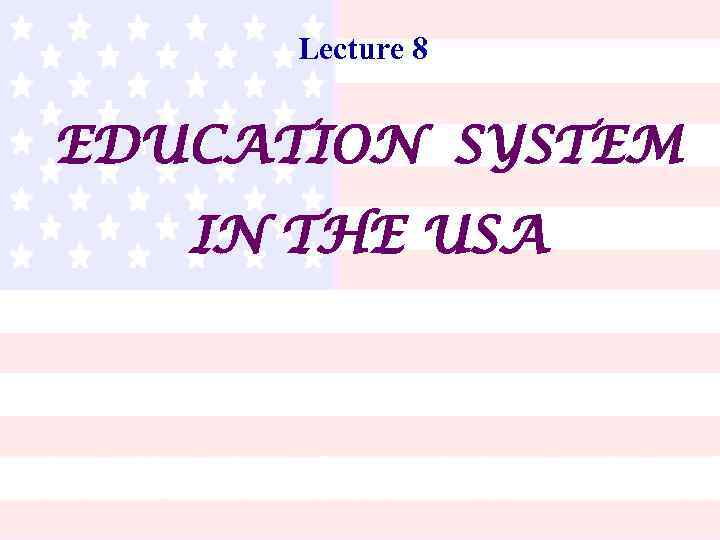 Lecture 8 EDUCATION SYSTEM IN THE USA
Lecture 8 EDUCATION SYSTEM IN THE USA
 Education in the USA LEVEL/GRADE Secondary Education Primary Education TYPICAL AGE High School (Grades 9 -12) Middle School (Grades 6 -8) Elementary School (Kindergarten + Grades 1 -5) Pre-School (Prekindergarten) 14 -18 11 -14 5 -11 3 -5
Education in the USA LEVEL/GRADE Secondary Education Primary Education TYPICAL AGE High School (Grades 9 -12) Middle School (Grades 6 -8) Elementary School (Kindergarten + Grades 1 -5) Pre-School (Prekindergarten) 14 -18 11 -14 5 -11 3 -5
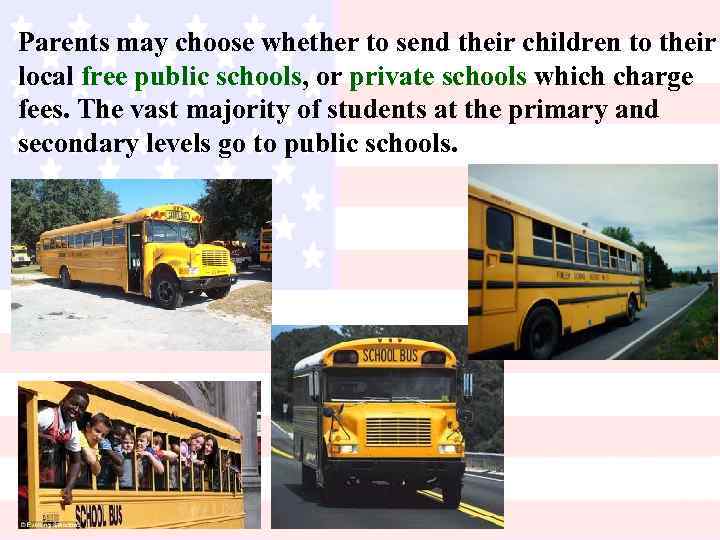 Parents may choose whether to send their children to their local free public schools, or private schools which charge fees. The vast majority of students at the primary and secondary levels go to public schools.
Parents may choose whether to send their children to their local free public schools, or private schools which charge fees. The vast majority of students at the primary and secondary levels go to public schools.
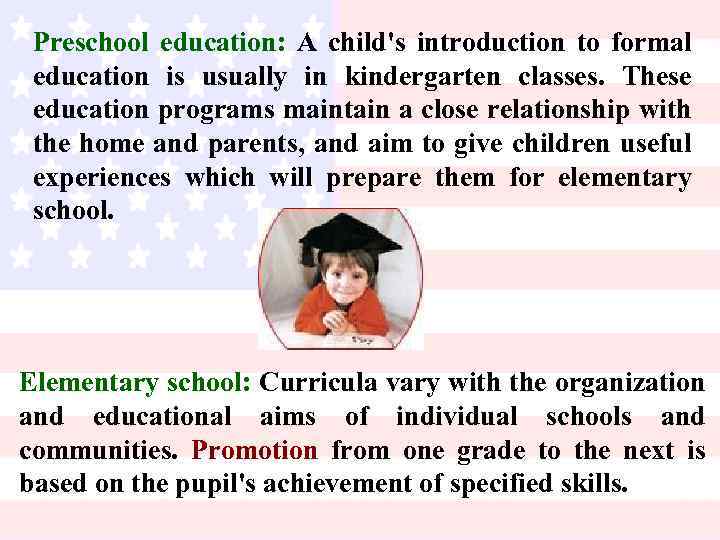 Preschool education: A child's introduction to formal education is usually in kindergarten classes. These education programs maintain a close relationship with the home and parents, and aim to give children useful experiences which will prepare them for elementary school. Elementary school: Curricula vary with the organization and educational aims of individual schools and communities. Promotion from one grade to the next is based on the pupil's achievement of specified skills.
Preschool education: A child's introduction to formal education is usually in kindergarten classes. These education programs maintain a close relationship with the home and parents, and aim to give children useful experiences which will prepare them for elementary school. Elementary school: Curricula vary with the organization and educational aims of individual schools and communities. Promotion from one grade to the next is based on the pupil's achievement of specified skills.
 Secondary School: Mostly - English, science, social studies, mathematics and physical education. Elective subjects may be chosen in the fields of foreign languages, fine arts and vocational training.
Secondary School: Mostly - English, science, social studies, mathematics and physical education. Elective subjects may be chosen in the fields of foreign languages, fine arts and vocational training.
 Basic subjects are required in the 10 th - 12 th grades, but in some high schools students may elect an increasing proportion of their work according to their interests.
Basic subjects are required in the 10 th - 12 th grades, but in some high schools students may elect an increasing proportion of their work according to their interests.
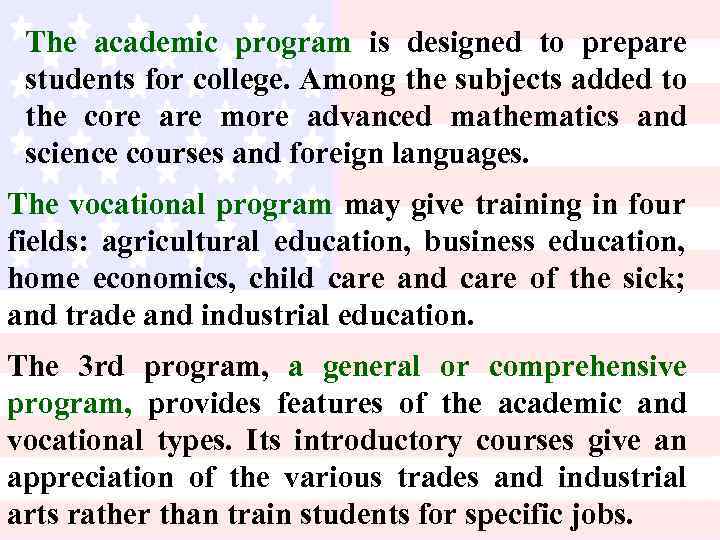 The academic program is designed to prepare students for college. Among the subjects added to the core are more advanced mathematics and science courses and foreign languages. The vocational program may give training in four fields: agricultural education, business education, home economics, child care and care of the sick; and trade and industrial education. The 3 rd program, a general or comprehensive program, provides features of the academic and vocational types. Its introductory courses give an appreciation of the various trades and industrial arts rather than train students for specific jobs.
The academic program is designed to prepare students for college. Among the subjects added to the core are more advanced mathematics and science courses and foreign languages. The vocational program may give training in four fields: agricultural education, business education, home economics, child care and care of the sick; and trade and industrial education. The 3 rd program, a general or comprehensive program, provides features of the academic and vocational types. Its introductory courses give an appreciation of the various trades and industrial arts rather than train students for specific jobs.
 Students receive "report cards" at least twice a year which indicate the grades they have received in each of the subjects they are studying.
Students receive "report cards" at least twice a year which indicate the grades they have received in each of the subjects they are studying.
 Graduation Day
Graduation Day
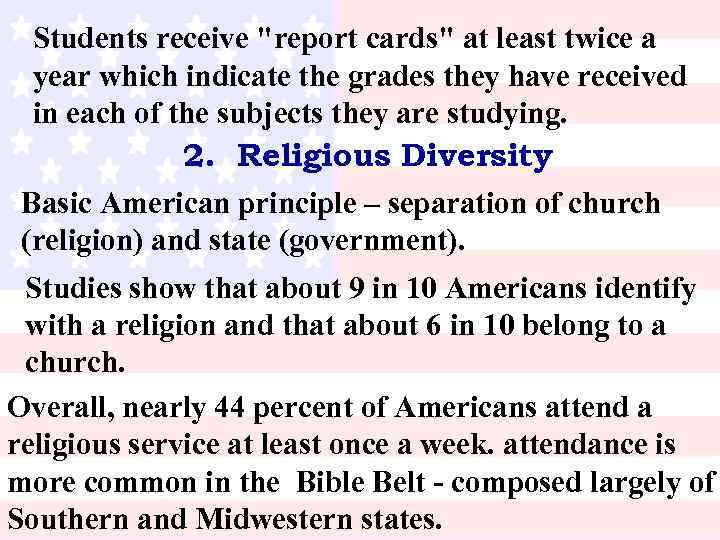 Students receive "report cards" at least twice a year which indicate the grades they have received in each of the subjects they are studying. 2. Religious Diversity Basic American principle – separation of church (religion) and state (government). Studies show that about 9 in 10 Americans identify with a religion and that about 6 in 10 belong to a church. Overall, nearly 44 percent of Americans attend a religious service at least once a week. attendance is more common in the Bible Belt - composed largely of Southern and Midwestern states.
Students receive "report cards" at least twice a year which indicate the grades they have received in each of the subjects they are studying. 2. Religious Diversity Basic American principle – separation of church (religion) and state (government). Studies show that about 9 in 10 Americans identify with a religion and that about 6 in 10 belong to a church. Overall, nearly 44 percent of Americans attend a religious service at least once a week. attendance is more common in the Bible Belt - composed largely of Southern and Midwestern states.
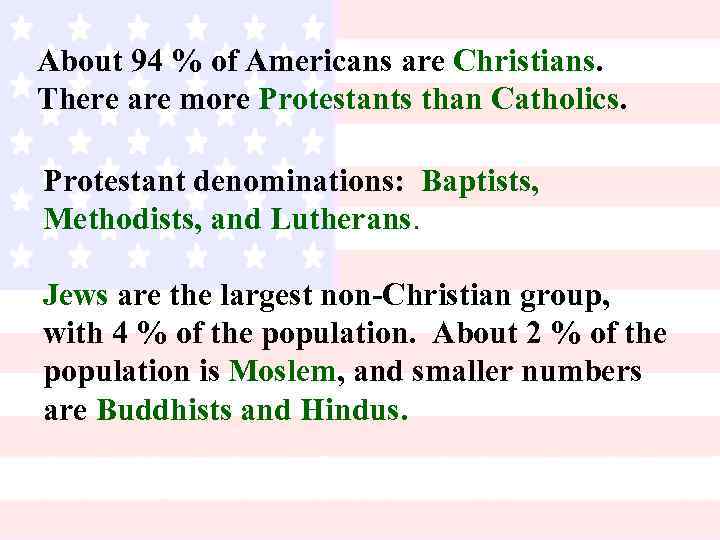 About 94 % of Americans are Christians. There are more Protestants than Catholics. Protestant denominations: Baptists, Methodists, and Lutherans. Jews are the largest non-Christian group, with 4 % of the population. About 2 % of the population is Moslem, and smaller numbers are Buddhists and Hindus.
About 94 % of Americans are Christians. There are more Protestants than Catholics. Protestant denominations: Baptists, Methodists, and Lutherans. Jews are the largest non-Christian group, with 4 % of the population. About 2 % of the population is Moslem, and smaller numbers are Buddhists and Hindus.